|
|
Compact Flash as an
Alternative to Hard Drives in Arcade Games
| Call me old fashioned, but putting hard
drives in arcade games was just a bad idea.
Granted that the games themselves definitely
benefit from the additional storage capacity
(Gauntlet Dark Legacy, San Francisco Rush,
Hyperdrive, Carnevil-- all excellent titles to be
sure), but the problem is that you'd be hard
pressed to find a less hospitable retail
environment than a commercial arcade for trying
to keep a harddrive working. Long hours,
jarring impacts, less than careful handling, and
lack of cooling all contribute to a high rate of
failure for hard drives in an arcade machine. Atari
and other manufacturers (Konami for example)
experimented by using 2.5" 'laptop' sized
hard drives instead of the 3.5" version
common in personal computers. Although the laptop
drives have superior shock and vibration
resistance (and more flexible power requirements)
they too still fail with time... No way around
it, a hard drive has bearings, motors, and an
aluminum disc spinning at >5000RPM waiting to
reduce any magnetoresistive read/write head to
shrapnel should the machine take an unexpected
jolt while operating.
|
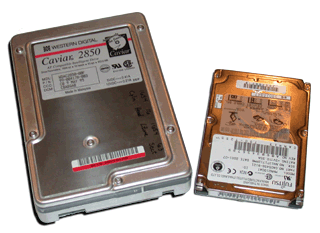 3.5" vs.
2.5" HD sizes
|
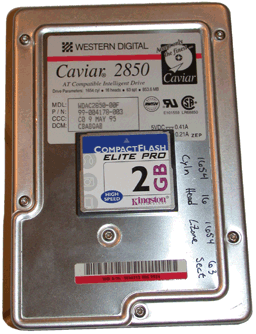 3.5" HD vs. Compact Flash
|
Alas, up until recent times the options for
storing large (Gigabyte sized) chunks of data
were largely limited to hard drives. Even a CD's
~650Mbyte capacity wouldn't come close to a
hard-drive. (CD-ROMs in arcade machines is
arguably an even *worse* idea than a harddrive--
one look at the amount of dust that gets inside
an arcade cabinet explains why CD a consumer CD
mechanism is not long for this world in an
arcade.) Recently a relatively new alternative
to using a harddrive in an arcade game has become
financially viable. Introduced in 1994, Compact
Flash cards have been around for a long time, but
driven by the popularity of digital cameras and
the ever expanding space requirements of embedded
systems, the lowly Compact Flash card has
suddenly become affordable in densities useful in
the arcade.
|
| For several years now I've been watching and
waiting for CF densities to go up and prices to
come down. In the last few months (as of the time
of this writing) this has finally happened. A
(relatively) high speed 2GByte Compact Flash card
can now be had for under $120.
Now we're talking! Compact Flash cards at a
firmware level are essentially ATA (Advanced
Technology Attachment-- the "IDE"
interface used in most modern IBM PC compatible
computers) devices that use the modern LBA
(Logical Block Addressing) scheme. What's that
mean? Basically they "look" just like a
regular harddrive as far as most software is
concerned. One need not but glance at a Compact
Flash card to conclude that they are radically
different electrically and mechanically however.
As luck would have it, there are a variety of
"CF to IDE" adapters on the market
which make it easy to plug a CF card into a
"normal" IDE interface. They typically
are available the $10-20
range.
|
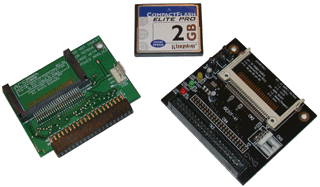 Compact Flash to IDE Adapters
(direct plug-in and cabled versions)
|
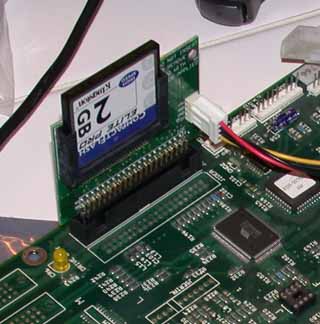 CF to IDE adapter
in place on Area51 PCB (click above for larger
image)
|
With a suitably large (>1GB) Compact Flash
in hand and an inexpensive ($12.99) CF to IDE
adapter I decided to finally sate my curiosity
after all these years. I was going to convert an
Atari Area51 boardset to use Compact Flash. The
process would seem to be simple-- connect the
Compact Flash card with the IDE adapter to a PC,
use a sector/LBA level disk copier ("DOLLY.ZIP" in this
case) to make a 1:1 image copy of the Area51
drive to the Compact Flash card, plug that into
the Area51 boardset and off we go!
The only problem was that I didn't have a good
Area51 hard drive to start with...
|
| Here's where the popularity of
MAME is an indisputable benefit to those of us
still using the "original" hardware for
our games. Area51 has been emulated by MAME for a
while, so compressed images of original Area51
harddrives are easily found on the Internet. In
my case, I located "area51.chd" and
proceeded to decompress it using the
"CHDMAN.EXE" program that comes with
most MAME executable archives. |

|
| |
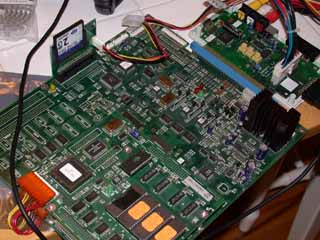
CF to IDE adapter in place on Area51 PCB
(click above for larger image)
|
I won't go into all the details of using
Dolly to get an image copied on to a new drive (a
good tutorial with all you need to know is here),
but suffice it to say that within ~15 minutes of
getting the Area51 image downloaded I had it
copied over onto a "Kingston 2GB Elite
Pro" Compact Flash card. (Simply treating
the CF+IDE adapter as any other harddrive with
Dolly.) I used a CF to IDE adapter that plugs
directly in to the 40 pin IDE connector to
eliminate the need for any cables. With my Area51
board and new CF->IDE drive in place I applied
power to my test rig and... Success!
|
| Compact Flash in this application eliminates
most all of the drawbacks to hard disk use
(moving parts, cooling, performance degradation
over time, etc.) and incurs none of the penalties
associated with solid state CF cards. (Since the
HD's in arcade games are generally read only,
Compact Flash's relatively slow write speed and
potential sector 'wear' issues are basically
moot.) Compact Flash may well have advantages
in some applications since there is virtually no
'seek' time which improves random access
performance. The overall burst datarate may not
be as good as an IDE harddrive, but game may not
rely on that.
|
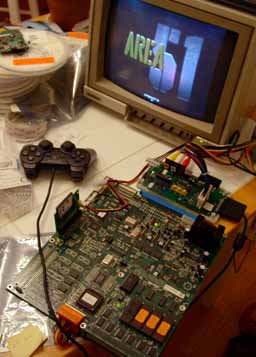 Area51/CF Running
(click above for larger image)
|
I tried the same experiment with a Judge Dredd
boardset (Aklaim-- using a Sony ZX hardware platform) and
did not have success with it. It's possible that the CF
card was coming ready too fast or too slow for the
firmware, or some other difference. YMMV. Once 4GB CF
cards drop some more I'll give them a try in the San
Francisco Rush and Guantlet Dark Legacy machines we have
in at Ground
Kontrol.
Compact Flash cards come in a variety of speed
variations-- some will read as slow as 4Mbytes/sec,
others as fast as 12Mbytes/sec. The 2GB card I have
probably falls in the 6-8Mbyes/sec range, so it's
possible that a faster (or even slower) card may work
well in some applications.
Written: 3/25/2005
|